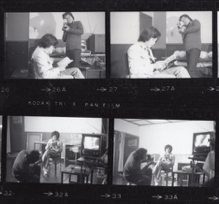Reframing the Moving Image: Art Osaka 2025 and the Power of Film in Contemporary Practice
- Gen de Art

- Jun 23
- 3 min read
Art Osaka 2025 concluded on a high note this June, marking another milestone in Japan’s premier contemporary art fair. It expanded its physical footprint at the historic Osaka City Central Public Hall, a national cultural property, and deepened its conceptual scope with a curated Screening Program—a thoughtful and ambitious undertaking that repositioned moving image works at the heart of contemporary art discourse.
The Screening Program, titled "To Be Being Seen: Exploring Artistic Expression in Moving Image Works from the 1960s to Today in Japan", offered a rare, multifaceted lens into Japan’s long and rich relationship with experimental cinema, video art, and interdisciplinary visual storytelling. Curated by curator Gen Umezu, with the support of Ishida (MEM), the program traced a lineage of creative innovation that challenged the conventional boundaries of genre, medium, and perception.

A Historic Setting for a Timeless Inquiry
The screenings were held in the Public Hall’s grand Main Hall, a storied venue that has hosted the likes of Helen Keller and Mikhail Gorbachev. Within this layered space, the Screening Program became more than a cinematic presentation—it became an act of cultural reflection. Free to the public, and carefully interwoven with the broader fair, the screenings invited audiences to not only observe but reconsider what it means to see, to perceive, and to express through moving images.
Across four tightly curated programs—A through D—the screenings spanned postwar avant-garde works, contemporary video experiments, and rarely seen archival footage. These programs were not merely historical retrospectives; they offered a dialogue between past and present, asking: what is the role of the moving image in art today, and where is it heading?
Spotlight: Techno Therapy and the Legacy of Interdisciplinary Art
Among the standout moments was the Special Screening: Techno Therapy, a two-part event revisiting the influential 1998 multimedia art project held at the same venue. Through two documentary films, the program illuminated a pivotal cultural moment. The post-screening talk, "What Exactly Was Techno Therapy?", featured prominent figures such as Yasumasa Morimura, which deepened the audience’s understanding of the aesthetic and philosophical context of the original event.
Thematic Depth: From Materiality to Metaphysics
Each of the four screening programs presented a different thematic inquiry:
Program A, titled KIKAIDE MIRUKOTO (Eye Machine / To See by Chance), focused on pioneering video artists and their groundbreaking interventions into the medium.
Program B, Arrival of the Moving Image, spotlighted the moment of “discovery” and emergence of moving image as a serious form of artistic engagement, notably featuring Iimura’s Kuzu (Junk).
Program C, Exploration of Expression, emphasized visual artists using film as an expressive material, with highlights including Yasumasa Morimura’s playful yet critical tribute to Andy Warhol.
Program D, For Moving Image Works to Come, embraced future-facing works that interrogated perception, digitality, and embodiment through the moving image.
Throughout, a recurring question echoed in the background: in an age saturated with moving images, what does it mean "to be being seen"?

A Forward-Looking Vision
At the symposium held on June 7, titled "Reflected Image / Visible Image — The Whereabouts of Moving Image Expression," curators and scholars including Ulanda Blair from M+ in Hong were invited to explore the current state of moving image art in Asia and its position within international contexts from multiple perspectives.In the end, Art Osaka 2025’s Screening Program did more than showcase important works—it offered a platform for reflection, remembrance, and renewal. As the world turns its gaze toward Osaka for the upcoming Expo, Art Osaka reminds us that some of the most transformative acts of cultural engagement don’t happen in grand spectacles, but in the quiet dark of a theater—frame by frame, image by image.










